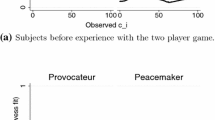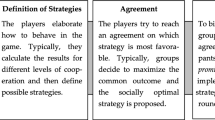Abstract
This paper presents a laboratory collective resistance (CR) game to study how different forms of non-binding communication among responders can help coordinate their collective resistance against a leader who transgresses against them. Contrary to the predictions of analysis based on purely self-regarding preferences, we find that non-binding communication about intended resistance increases the incidence of no transgression even in the one-shot laboratory CR game. In particular, we find that the incidence of no transgression increases from 7 percent with no communication up to 25–37 percent depending on whether communication occurs before or after the leader’s transgression decision. Responders’ messages are different when the leaders can observe them, and the leaders use the observed messages to target specific responders for transgression.
Similar content being viewed by others
References
Acemoglu, D., Robinson, J., & Verdier, T. (2004). Kleptocracy and divide-and-rule: A model of personal rule. Journal of the European Economic Association Papers and Proceedings, 2, 162–192.
Battalio, R., Samuelson, L., & Van Huyck, J. (2001). Optimization incentives and coordination failure in laboratory stag hunt games. Econometrica, 69, 749–764.
Bosman, R., & van Winden, F. (2002). Emotional hazard in a power-to-take experiment. Economic Journal, 112, 147–169.
Cason, T., & Mui, V.-L. (2007). Coordinating collective resistance through communication and repeated interaction. Working Paper. Purdue and Monash Universities.
Charness, G., & Dufwenberg, M. (2006). Promises and partnership. Econometrica, 74, 1579–1601.
Charness, G., & Rabin, M. (2002). Understanding social preferences with simple tests. Quarterly Journal of Economics, 117, 817–869.
Cooper, D., & Kagel, J. (2005). Are two heads better than one? Team versus individual play in signaling games. American Economic Review, 95, 477–509.
Fehr, E., & Fischbacher, U. (2004). Third-party punishment and social norms. Evolution and Human Behavior, 25, 63–87.
Fehr, E., & Schmidt, K. M. (1999). A theory of fairness, competition, and cooperation. Quarterly Journal of Economics, 114, 817–868.
Fischbacher, U. (2007). z-Tree: Zurich toolbox for readymade economic experiments. Experimental Economics, 10, 171–178.
Gibbons, R. (2001). Trust in social structures: Hobbes and Coase meet repeated games. In K. Cook (Ed.), Trust in society. New York: Russell Sage Foundation.
Gintis, H., Bowles, S., Boyd, R., & Fehr, E. (2005). Moral sentiments and material interests: Origins, evidence, and consequences. In H. Gintis, S. Bowles, R. Boyd, & E. Fehr (Eds.), Moral sentiments and material interests: The foundation of cooperation in economic life. Cambridge: MIT.
Miller, G. (1992). Managerial dilemmas: The political economy of hierarchy. New York: Cambridge University Press.
Van Huyck, J., Battalio, R., & Walters, M. (1995). Commitment versus discretion in the peasant–dictator game. Games and Economic Behavior, 10, 143–170.
Van Huyck, J., Battalio, R., & Walters, M. (2001). Is reputation a substitute for commitment in the peasant–dictator game? Working Paper, Texas A&M University.
Weingast, B. (1995). The economic role of political institutions: Market-preserving federalism and economic development. Journal of Law, Economics, and Organization, 11, 1–31.
Weingast, B. (1997). The political foundations of democracy and the rule of law. American Political Science Review, 91, 245–263.
Weingast, B. (2005). The constitutional dilemma of economic liberty. Journal of Economic Perspectives, 19, 89–108.
Williamson, O. (1985). The economic institutions of capitalism. New York: The Free Press.
Author information
Authors and Affiliations
Corresponding author
Electronic Supplementary Material
Rights and permissions
About this article
Cite this article
Cason, T.N., Mui, VL. Communication and coordination in the laboratory collective resistance game. Exp Econ 10, 251–267 (2007). https://doi.org/10.1007/s10683-007-9181-1
Published:
Issue Date:
DOI: https://doi.org/10.1007/s10683-007-9181-1




